
4.5 x 4.5 inches
| Core Memory |

4.5 x 4.5 inches
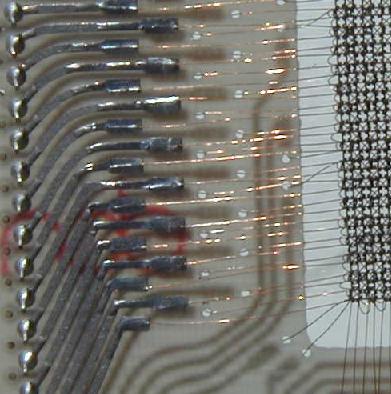
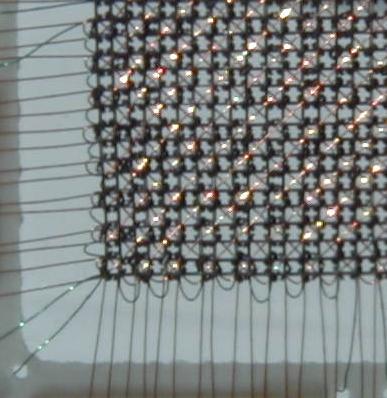 Each stack had eight memory planes. Each memory plane had a fine mesh of wires with tiny magnetic "doughnuts" or rings where the lace of wires crossed. In the midst of glistening fine copper wires, the little doughnut could be magnetized one way or the other, thus, signaling an "on" or "off" or 0 or 1 in the binary numbering system needed by computers. On each memory plane, there were 1024 of these tiny magnetized rings. Each represented one bit of information. Here is literally the last possible look at the location of a bit of binary information Soon integrated circuits made this beautiful mesh unnecessary and the technology was unused. Now millions of bits of information rest in a tiny single chip. |
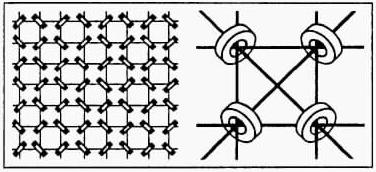
The UNIVAC ganged 8 planes into a stack. Each stack was 8K bytes. Each plane
was hand assembled and cost $6000 per plane in the 50's. The core memories
consisted of a tiny magnetic doughnuts (1024 in this case). Each doughnut
(core) held a single bit. The magnetic polarity of the core held the bit value.
To write a bit, there were an X and Y wire. To read a bit there was sense
wire. The read process consisted of writing a value to a specific core (indexed
via the X and Y wires). If the core flipped magnetic polarity, the sense wire
would see it, and the computer would know the bit had been of opposite polarity.
If the sense wire did not detect a flip, then the bit value was the same as
the one being currently written. Either way, the bit had to be rewritten.
Core memory is non-volitile. So whatever was last written (back in the 50s)
on the plane I bought is still there. I find this very cool.
---
An inclusive history of the invention of magnetic core memory
would include John Presper Eckert, An Wang, Jay Forrester, Jan Rajchman, Mike
Haynes and William Papian. Eckert was an engineer that contributed heavily
to the ENIAC project, the first electronic computer developed. Wang, as a
researcher at the Harvard Computing Lab in 1948, was the first person to implement
magnetic cores to store information. These two researchers contributed to
the early attempts at creating magnetic core memory that led to the rise of
a magnetic core culture. By 1950, Forrester, Rajchman, Haynes and Papian joined
this culture and contributed to its ultimate success. Forrester, the leader
of Project Whirlwind, adopted magnetic cores in 1949 to meet the memory needs
of the project. His ideas on memory were implemented through the research
efforts of Papian.
Rajchman, an engineer at RCA, developed his ideas of using magnetic
memory in parallel with Forrester and engaged in a long patent suit with him
over the invention. Haynes, as a Ph.D. student at the University of Illinois,
applied magnetic cores to implement logic and later established the magnetic
core research efforts at IBM, the company that ultimately benefited the most
from the invention. These researchers all joined and contributed to the magnetic
core culture that was solidified through the success of Project Whirlwind.
---
Women using stereo microscopes worked hour after hour stringing,
by hand, the wires through these cores that are now standing up on edge with
their holes all perfectly lined up. The wires, thinner than hair, have long...
12 to 24 inch stainless "needles" attached to the end, simply for rigidity.
The wire, normal, albeit tiny, is insulated with enamel, or
most recently [then] "Formvar"... a high-resistance material that can be stripped
with heat, whereas enamel cannot. They would tediously string these rows and
rows of core with the needle/wire assembly, then cut the end of the wire close
to the appropriate solder land, (leaving a "service loop" for future use),
and the coreplane would be completed. One defective or broken core (and they
are very fragile), would entail removing the wires associated with that core,
removing the core, usually a chunk at a time, and inserting a new core in
its place. The removed wires are then replaced...
|
Core memory stack
|
|
|
This is a stack of 13x4096bits---> This stack is approx. 8 X 8 X 8 inch. |
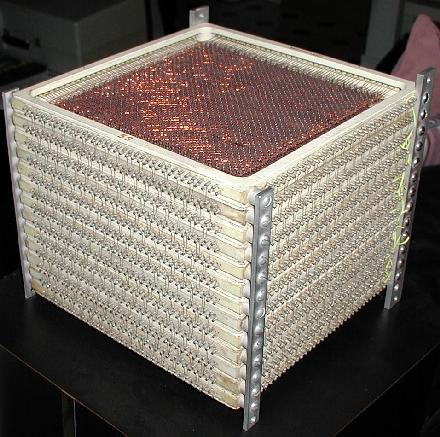 |
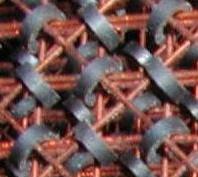 |
<---A close up of the tiny magneticdoughnuts.
|